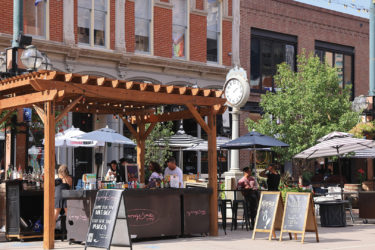The Top 7 Ways the Pandemic Changed Colorado (Maybe Forever)
We look backward—and forward—five years after COVID-19 altered the course of our lives here at elevation.

March 9, 2020
Outside, the sun was shining on a 50-degree, bluebird day in Denver. But inside Star Bar, a divey booze hall in the Ballpark neighborhood, the low lighting befitted the prevailing mood. It was roughly 4 p.m., and my longtime colleague and I were numbing our disappointment at the cancellation of a work trip to New York City because of what everyone was calling “a novel coronavirus.” After a second (third?) beer, I remember turning to look at my friend, sighing, and then saying, “Do you think we’ll look back on today and say, Those were the good ol’ days?”
Less than a week before, health officials confirmed Colorado’s first case of what would quickly become known as COVID-19. Two days later, the World Health Organization declared the viral outbreak emanating from the Chinese city of Wuhan a pandemic. Over the ensuing three years, more than 1.7 million Coloradans would be sickened, and more than 15,600 would die. And every day since, we have existed in a different era—an era that despite the recent and liberal use of the phrase “post-pandemic” seems to be lingering, not unlike the symptoms of the bug itself sometimes do.
In much the same way the virus affected distinct groups of people in sometimes mysterious and often upsetting ways, the social and economic consequences of humanity’s response to the pandemic have plagued countries and cities in strikingly disparate manners. Although the United States ranks among the top 10 countries for economic recovery, according to international think tank the Horizon Group, many of America’s once-vital urban centers—from New York City to Chicago to San Francisco to, yes, Denver—are languishing.
It’s not difficult to see why. Star Bar has endured, but hundreds of other food-and-drink spots within Denver city limits were not so lucky. Foot traffic in the Central Business District has not yet fully recovered. Former office workers have remained devoted to their kitchen tables. Crime shot up in 2021 and 2022, declined in 2023, and rose again in the second half of 2024. Homelessness has more than doubled since 2019. Colorado as a whole has suffered, too. Vaccination rates tumbled. Concerning levels of alcohol consumption have persisted beyond the early days of quarantine. Traffic fatalities increased. Loneliness caused by social isolation has not entirely abated.
And yet, the pandemic’s lasting impacts aren’t universally awful. Bright spots, big and small, are there. “Perception is the real challenge for recovery,” says Kourtny Garrett, president and CEO of the Downtown Denver Partnership. “Not that Denver doesn’t have problems—it does—but the reality of our recovery is much more positive than statistics and lists suggest. Getting people to see that is the challenge.”
Below, we take a statistical and humanistic look at some of the local impacts, both the bad and the good, of the COVID-19 pandemic. In doing so, what’s clear is that, five years on, we’re only beginning to accurately measure and truly understand its ramifications.












